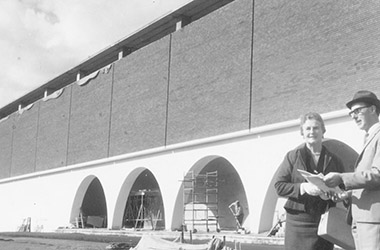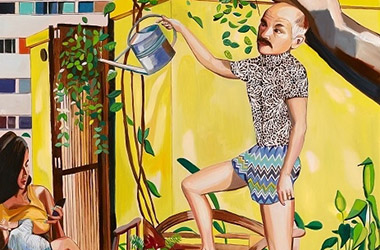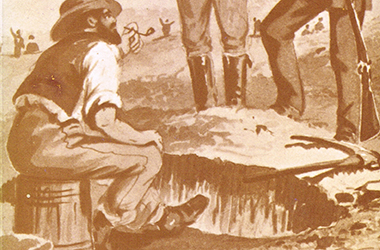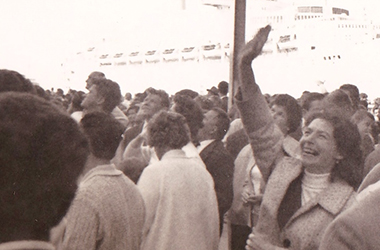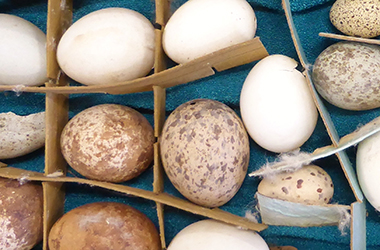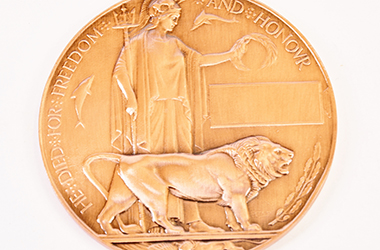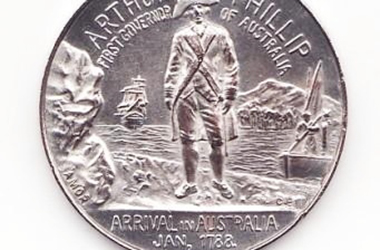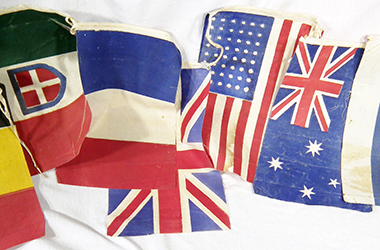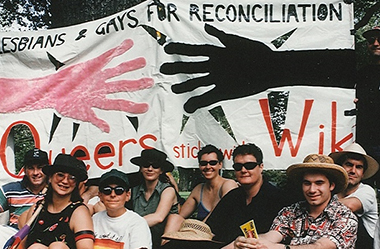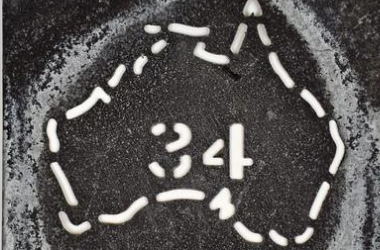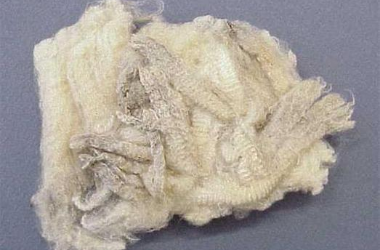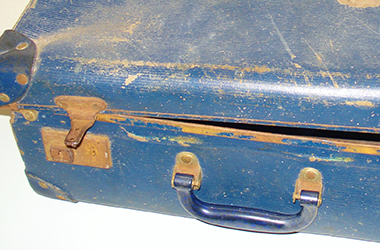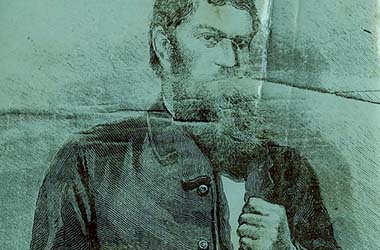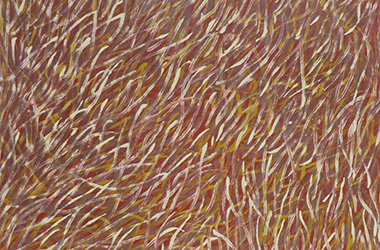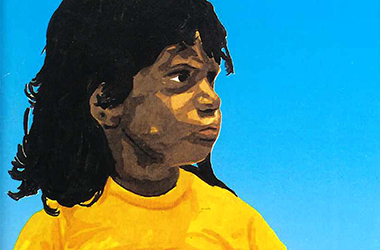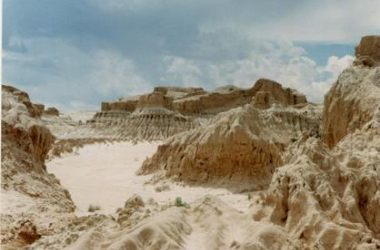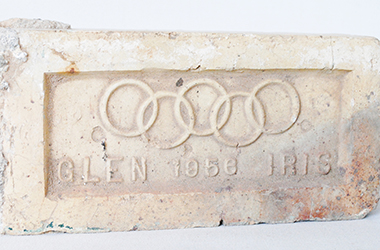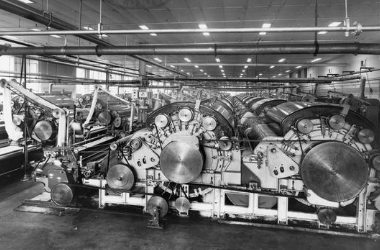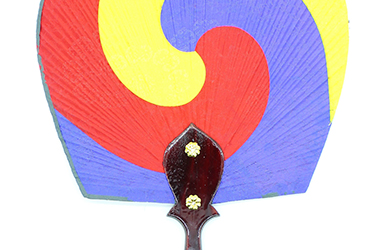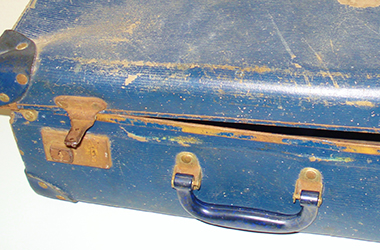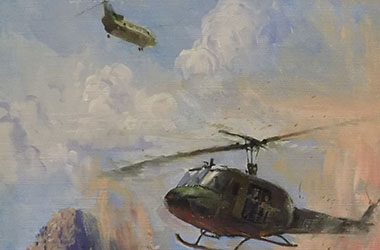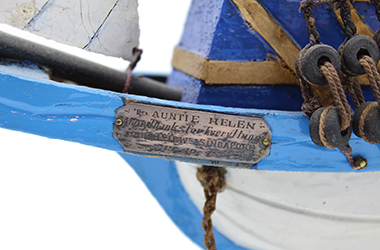Browse stories
-
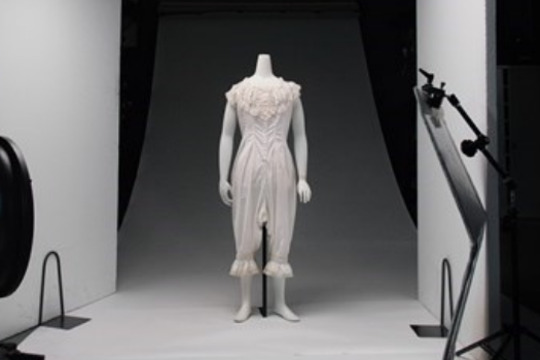 Danielle Whitfield
Danielle WhitfieldPhotographing Fashion
The three-dimensional aspect requires a different approach that encompasses numerous angles and mannequin positions as well as complex lighting techniques.
The photographic treatment is informed by the garment’s condition, history, fabric and construction techniques. As such, this kind of photography is a team effort between myself, the textiles conservator and the curator.
-
 Mark Brandi
Mark BrandiPortable Justice: The old Bacchus Marsh police lock-up
Scratched into the timber wall of the old Bacchus Marsh police lock–up, these crudely formed words might be a prisoner’s repentance before finally going straight. Or perhaps their regret was short-lived, soon returning to a life of crime.
We will never know if they remained faithful to their promise, but the pledge gives life to the bitter solitude of this place, and others like it.
Prior to the widespread construction of police lock-ups, suspected criminals were subject to primitive forms of detention. In some towns, alleged culprits were tied to trees while awaiting trial, and were often subject to threats of lynching.
-
 Alana Bennett Mazzilli
Alana Bennett MazzilliPrisoner of War & Internment Camps: Tatura and Rushworth
Australia, like many other countries, ran internment camps throughout the war years in both New South Wales and Victoria.
During this period, there were two significant camps in country Victoria’s Goulburn Valley region, at Tatura and Rushworth. A total of seven camps were spread between the two regional communities, housing Prisoners of War, enemy alien migrants and civilians living in Australia or other Allied territories and countries.
-
 Kate Luciano
Kate LucianoSchool Days: Education in Victoria
The exhibition, School Days, developed by Public Record Office Victoria and launched at Old Treasury Building in March 2015, is a history of more than 150 years of schooling in Victoria.
It is a history of the 1872 Education Act - the most significant education reform in Victoria, and a world first! It is a history of early schooling, migrant schooling, Aboriginal schools, women in education, rural education and, of course, education during war time (1914-1918).
This online exhibition is based on the physical exhibition School Days originally displayed at Old Treasury Building, 20 Spring Street, Melbourne, www.oldtreasurybuilding.org.au and curated by Kate Luciano in collaboration with Public Record Office Victoria.
-
 Simone Ewenson
Simone EwensonSip, Slurp, Gulp! Tea Mania
From the tranquillity and purity of Japanese Tea Ceremony (Sado) to the hospitality and friendship represented in Moroccan tea traditions, enjoying tea is a much loved and revered ritual practiced around the globe.
Tea Mania traces the history of tea and reflects on the distinctive Australian flavour of tea consumption as it intertwines with global politics, economics and the rise of consumerism.
-
 Colleen McGonegle
Colleen McGonegleA Snappy, Collapsible Hat
On the outside it appears to be an ordinary top hat, but hidden on the inside is a technological innovation at least forty years in the making...
-
 Lynda Tieman
Lynda TiemanS.S. Casino
The steamship SS Casino served the Western District of Victoria for almost fifty years during the late 19th and early 20th centuries.
A popular cargo ship, the Casino was a regular sight on the Moyne river and along the coast. The ship was an integral part of coastal life until she was shipwrecked in the 1930's, and objects from the Casino can now be found in collections from across the region and gathered here on Victorian Collections for the first time.
Transporting large quantities of wool, potatoes, onions, grain, sheep, cattle and other produce provided a great economic opportunity to business men in Port Fairy and in March, 1882, the Belfast & Koroit Steamship Company was formed with a capital of £20,000 in 10,000 shares. The SS Casino on her delivery voyage from England was due in Warrnambool to load potatoes for Sydney and the Directors inspected and purchased her there.
She arrived in Port Fairy on 29th July, 1882, steaming triumphantly up the Moyne River, and was greeted with cheers by a large crowd, many of whom had come from the surrounding countryside. She operated alone for almost all of the next 49 years. She was much loved by the whole Port Fairy community and the coastal ports that she serviced, bringing news and goods from far away and transporting passengers.
A celebration for the Casino's fiftieth anniversary was planned for the 29th July, 1932. Unfortunately soon after 9 o'clock on the morning of Sunday 10th July, 1932, disaster struck when the Casino was lost at Apollo Bay together with the lives of the Captain and 9 crew members.
-
 Rachael Cottle
Rachael CottleStories of Support
The 2016 Museums Australia (Victoria) Conference held at Phillip Island in October, was the inspiration for this story. A drive around the Island on arrival unearthed a surprise in Newhaven - the former Boys Home standing silent and abandoned, looming over the ocean.
Care homes were once an essential part of Victorian life. The gold rush and population increase in Victoria created a need for charitable organisations to provide care to those who could not care for themselves, most notably children. Providers of care have also included societies for people with special needs including the 'Deaf and Dumb', and the asylums and hospitals of Victoria. This continued until the late 20th century when reform was prompted by revelations of abuse in the institutional system. The care model has since shifted towards kinship and foster services.
Victoria’s former institutions of care are an important part of our history. Whilst many of the buildings—often architecturally brilliant— no longer exist, they are remembered through the photographs and artefacts held by collecting organisations across the state and catalogued here on Victorian Collections.
-
 Liza Dale-Hallett
Liza Dale-HallettStories of Women on the Land
From the grinding stones of Australia’s first farmers, Wagga quilts, butter pats and recipe books to family photographs, garden tools and agricultural equipment – women’s farm work is frequently found in museums. The contribution of women to Australian agriculture has a rich and very deep history. Yet these stories have been unacknowledged and continue to be undervalued.
The nature of women’s farm work is often rendered invisible because much of it is intangible and ephemeral, is characterised by relationships and oral tradition, and dismissed as just ‘domestic’ work when in fact this work is what has often sustained families, farms and communities. The layers of invisibility are even deeper for migrant and Indigenous women.
There has also been a long history of official barriers to recognising women’s work on the land. Farm women were deliberately omitted from the 1891 Victorian Census. Women were excluded from agriculture courses up into the early 1970s. It wasn’t until 1994 that women were legally recognised as farmers, prior to this they were defined as ‘non-productive "sleeping" partners’. And, It is only in recent years that scholars have finally acknowledged the 40-50,000 years of Indigenous knowledge and practice in complex systems of agriculture and aquaculture.
Victorian museums are a treasure trove of untold stories about the extraordinary lives of farm women and how they have shaped our land and rural communities.
-
 Kitty Owens
Kitty OwensSummon the Living
Prior to the advent of electronic sound systems, bells were heard ringing throughout the day.
Large bells were attached to buildings. Handheld bells sat on tables and mantel pieces. Bells rang for morning prayer, school time, half time, and dinner time. Bells announced a fire in town or the death of a local. Some bells were passed around within their local community, or re-purposed as presentation gifts, being easily engraved and potentially useful.
This story was originally inspired by Graeme Davison’s book The Unforgiving Minute: How Australia Learned to Tell the Time.
-
 Cameron Auty
Cameron AutySymbols of Survival
The internment of civilian and military populations was widespread during the twentieth century.
The Australian experience of imprisonment is complex: Captured Australian soldiers faced years in Asian and European camps, often returning home traumatised or suffering physically. Australia also interned enemy soldiers and civilian residents with ties to enemy nations.
The physical objects created by internees and by the societies that imprisoned them can tell stories not found in archives. Prisoners expressed themselves through art, doctors built tools and internees made furniture to fill sparse barracks. Similarly, authorities used the internee experience to tell stories, and the image of the prisoner could be used to communicate power or compassion depending on the audience.
These objects are comparatively rare in military collections, as internees faced obstacles when producing physical objects. Lack of access to materials, hostile guards and strict rules, low morale and poor health all contributed to their scarcity.
Victorian Collections provides a window into the story of internment. This story uses objects drawn from Victoria’s collecting organisations to explore the internee and prisoner experience.
-
 Amy Tsilemanis
Amy TsilemanisTalking Shop: Ballarat in Business & City Life at Ballaarat Mechanics' Institute
Between January and April 2019, the Ballaarat Mechanics' Institute hosted the exhibition Talking Shop, exploring a world of Peters ice cream cones, milk bars, vintage advertising, historic photographs and ephemera.
This nostalgia was complemented by contemporary photographs and creative responses exploring Ballarat’s shops and businesses. Community events throughout the exhibition invited the people of Ballarat to contribute their images and memories to the BMI collection, and are shared here in this story.
This exhibition was curated by Amy Tsilemanis at the BMI who worked with artists Pauline O'Shannessy-Dowling and Margie Balazic, collector John Kerr and Ballarat businesses, council, and schools to create a 'generative' exhibition where material and collaborations could grow.
Wanting to know more about Ballarat’s booming business history? Take a digital tour of the exhibition here: https://invictoria.com.au/talking-shop-exhibition
-
 Megan Cardamone
Megan CardamoneTennis in Pictures
Today, for many Australians, especially Melburnians, watching and attending the tennis, and supporting favourite players is a popular aspect of summer.
What was it like to be a top player in times past and how has every aspect of tennis - the travel, the venues, the people, the social context - changed over time?
Tennis Australia collects and preserves items of tennis heritage as a way of safekeeping the history of Australian tennis. Among its holdings are a large number of historical images. It also fosters relationships with champions of the past so that emerging players can learn from their experience.
In 2015, two of these champions - Thelma Coyne Long and Neale Fraser - shared their memories of significant images in the Tennis Australia collection.
The result is this story: Tennis In Pictures, in which two tennis greats reminisce and share in a very personal way their memories about fascinating moments in our sporting history.
Thelma Coyne Long recalls the overseas trip in 1938 with three other female team-mates, the long ship journey, the excitement and novelty of travel and the confining attitudes towards women and female athletes in 1930s Australia.
As he examines historic Davis Cup images, Neale Fraser is reminded of some of his greatest team and individual triumphs and fondest memories from a lifelong tennis career.
-
 Claire Capel-Stanley
Claire Capel-StanleyThreads: Quilts & waggas
Quilting is often thought of as a pastime more than an art form.
A domestic craft practiced mainly by women, we think of quilt-makers working individually or in intimate circles, sharing stitches and scraps of fabric along with gossip and hushed conversation. In truth, quilts are complex objects.
Both utilitarian and artistic, quilts not only testify to the industriousness and ambition of their makers, but they also enclose generations of economic, cultural and social change.
Quilts tell stories and are objects of inference, through which multiple histories can be glimpsed, imagined, covered over: threads gathered and dropped. Few objects are as riven with the small and large shocks, fears, desires and dreams of everyday life.
-
 Natalie Mastoris
Natalie MastorisTides of Change: Women of the Melbourne Metropolitan Board of Works (MMBW)
In the lead up to International Women’s Day held on the 8th of March 2018, Melbourne Water celebrates and shines a spotlight on the past and continuing achievements of women within the organisation. Please join us in exploring the major milestones and social change within the MMBW, Melbourne Water and the Victorian Public Service.
Melbourne Water’s predecessor, The Melbourne and Metropolitan Board of Works (MMBW), was formed in 1891 to take responsibility for the city’s water supply and treatment. Initially, female employees were appointed to administrative and clerical positions. It wasn’t until 1939 that women stepped into more official, technical and specialist roles. These included positions such as chemistry assistants, machine operators and assistant drafts women.
Not only were women’s roles at MMBW based on their contribution to the operations of the organisation, many women were involved in social, recreational and cultural activities. Perhaps the greatest legacy of women at the MMBW was their efforts in building communities, enriching and empowering the lives of those around them.
-
 Museums Victoria
Museums VictoriaTime Flies in Museum Collections: Ornithology in Victoria
Natural science collections are vast treasure troves of biological data which inform current research and conservation.
Alongside bird skins, nests, eggs and DNA samples sits a magnificent collection of rare books, illustrations and images which charts the history of amateur and professional ornithology in Victoria.
Whilst the big names such as John Gould (1804–1881), are represented, the very local, independent bird observers such as John Cotton (1801-1849) and Archibald James Campbell (1853–1929) made some of the most enduring contributions.
The collections also document the bird observers themselves; their work in the field, building collections, their efforts to publish and the growth of their ornithological networks. Captured within records are changes in ornithological methods, particularly the way data is captured and published.
However the data itself remains as relevant today as it did when first recorded, 160 years of collecting gives us a long-term picture of birdlife in Victoria through space and time.
-
 Rohan Long
Rohan LongVictorians & Native Birds: An evolving relationship
The people of Victoria have had a constantly changing relationship with their native birdlife.
Ever-present and iconic, we’ve put Australian birds on official state heraldry and on tomato sauce bottles and biscuit packets. There has always been an immense fondness and respect for our unique birds. However, attitudes towards wildlife generally and birds specifically have undergone seismic paradigm shifts over the last few hundred years.
Looking at objects catalogued here on Victorian Collections, we can map this change and trace the ways that Victorians have interacted with birds, from Indigenous spirituality to citizen science programs.
-

William Barak
Diplomat, artist, story-teller and leader, Wurundjeri (Woiwurung) man William Barak worked all his life to protect the rights and culture of his people, and to bridge the gap between settlers and the land’s original custodians.
Barak was educated at the Yarra Mission School in Narrm (Melbourne), and was a tracker in the Native Police as his father had been, before becoming ngurungaeta (clan leader). Energetic, charismatic and mild mannered, he spent much of his life at Coranderrk Reserve - a self-sufficient Aboriginal farming community in Healesville.
Barak campaigned to protect Coranderrk, worked to improve cross-cultural understanding and created many unique artworks and artifacts, leaving a rich cultural legacy for future generations.
CULTURAL WARNING: Aboriginal and Torres Strait Islander users are warned that this material may contain images and voices of deceased persons, and images of places that could cause sorrow.
Further information on William Barak can be found at the State Library of Victoria's Ergo site.
-
 History Teachers Association Victoria / Heide Museum of Modern Art
History Teachers Association Victoria / Heide Museum of Modern ArtYingabeal: Indigenous geography at Heide
Yingabeal is the name of a scarred tree in the grounds of Heide Museum of Modern Art in the suburb of Bulleen, Victoria.
Before Heide became an art gallery, it was the home of John and Sunday Reed. They were patrons of the arts who arrived at the property in 1934 and created a place where artists could come to work. After they died, their house became the Heide Museum of Modern Art, a gallery that displays Australian art, including the collection that the Reeds built up in their lifetime.
But for thousands of years before the arrival of the Reeds, the land belonged to the Wurundjeri people of the Kulin Nation. Scarred trees are those that have been permanently marked by Indigenous communities using their bark to make tools or equipment.
-
 Catherine Bessant
Catherine BessantLighthouses: The romance and the reality
Everybody loves a lighthouse. The image of the shining light in a tall tower seem to stir something in everyone’s imagination. We imagine a romantic life in one of these isolated outposts. Away from the hustle and bustle, in a sublime and wild setting, at one with the elements…
The reality was a little different. Lighthouses were built on remote sections of the Victorian coast or on islands, some only accessible by sea. Light keepers and their families relied on infrequent supplies brought in by ships. During emergencies there might be no help at hand and the consequences could be tragic.
Over 600 shipwrecks are recorded along the treacherous Victorian coastline with the loss of many lives. Many of the wrecked ships were bringing people from all over the world to try their luck on the goldfields. The establishment of a series of Lighthouses along Victoria’s coast from the mid 1800’s didn’t stop the wrecks altogether; human error was often a contributing factor in these disasters.
Lighthouse keepers had their part to play, sometimes helping shipwreck survivors and communicating news of these disasters to the outside world.
Adventurous travellers have been visiting lighthouses since soon after they were built. They are now iconic destinations that most people can access and they haven’t lost their romantic appeal.
-
 Isaac Douglas Hermann & Heather Arnold
Isaac Douglas Hermann & Heather ArnoldCarlo Catani: An engineering star over Victoria
After more than forty-one years of public service that never ended with his retirement, through surveying and direct design, contracting, supervision, and collaborative approaches, perhaps more than any other single figure, Carlo Catani re-scaped not only parts of Melbourne, but extensive swathes of Victoria ‘from Portland to Mallacoota’, opening up swamplands to farming, bringing access to beauty spots, establishing new townships, and the roads to get us there.
-
 Lucinda Horrocks
Lucinda HorrocksThe Missing
When WW1 brought Australians face to face with mass death, a Red Cross Information Bureau and post-war graves workers laboured to help families grieve for the missing.
The unprecedented death toll of the First World War generated a burden of grief. Particularly disturbing was the vast number of dead who were “missing” - their bodies never found.
This film and series of photo essays explores two unsung humanitarian responses to the crisis of the missing of World War 1 – the Red Cross Wounded and Missing Enquiry Bureau and the post-war work of the Australian Graves Detachment and Graves Services. It tells of a remarkable group of men and women, ordinary people in extraordinary circumstances, who laboured to provide comfort and connection to grieving families in distant Australia.
-
 Paige Gleeson
Paige GleesonMaking Do on ‘the Susso’: The material culture of the Great Depression
There are currently 5.25 trillion pieces of plastic in our oceans. The demands on renewable sources like timber, clean water and soil are so great they are now being used at almost twice the rate that the earth can replenish them. Finite resources like fossil fuel are consumed at an alarming rate, changing the earth’s climate and pushing animal species to the brink of extinction. Current patterns of consumption are exceeding the capacity of the earth’s ability to provide into the future.
All over the world, environmental movements concerned with sustainability have sprung up in response. Conscious consumers are advocating for their right to repair their own electronic devices, fighting a culture of planned obsolesce and disposability. Others are championing the repair, reuse and recycling of clothing and household goods to extend their lives. Reducing waste in the kitchen and promoting food options with lower environmental impact has become increasingly popular.
Climate change may be a uniquely twenty-first century challenge, but sustainability has a history. In 2021 many people are making a conscious choice to embrace anti-consumerism, but during the Great Depression of the 1930s it was necessity that drove a philosophy of mend and make do.
In 1929 stock markets crashed and sent economies around the western world into free fall, triggering the Great Depression. Australia’s economic dependence on wool and wheat exports meant that it was one of the worst affected countries in the world. The impact of the Depression on the everyday lives of Australians was immense. Not everyone was effected with the same severity, but few escaped the poverty and austerity of the years 1929-1933 unscathed.At the height of the Depression in 1932 Australia had an unemployment rate of 29%, and thousands of desperate people around the country queued for the dole. Aboriginal Australians were not eligible for the dole, and had to rely solely on government issued rations.
-

Out of the Closets, Into the Streets
This project documents the very beginning of the Gay Liberation Movement in Melbourne.
Through the manifestos, photographs, flyers and recollections of those who were part of the movement, this digital story explores the ways in which gay people found their voice in Melbourne, and refused to pass for straight anymore.
Gay Liberation had both local and imported roots. Internationally the New York City Stonewall riots in 1969 sparked off a new phase of radical gay politics, drawing on the momentum of activist organisations and protests across America throughout the 1960s, but locally few people took immediate notice, though fledgling advancements in homosexual law reform had developed within the civil liberties movement.
In Melbourne, the short-lived Daughters of Bilitis (later Australasian Lesbian Movement) arrived quietly on the scene in January 1970, gaining media coverage but limited influence. The real start to the Australian gay movement occurred in September 1970 with the formation of the Campaign Against Moral Persecution, or CAMP, in Sydney. Within two years there were CAMP branches in most Australian capital cities, with the Melbourne branch established in January 1971, soon renamed Society Five. However, despite the success of these organisations in counselling and socialising and later law reform, the relatively closeted nature of Society Five was never radical enough for some activists.
Gay Liberation arrived in Australia first in Sydney in 1971 and soon after in Melbourne and other states. By 1972 small Gay Liberation groups were springing up around the country. The differences between Gay Liberation and Society Five were in practice small, but those in Gay Liberation prided themselves on their commitment to bringing about radical social change.
Influenced by the counter-cultural movements and radical political movements of the 1970s, the politics of gay liberation became an all-encompassing liberation, an ‘embodied politics’ that saw liberation in all aspects of one’s life, from households to classrooms, sexual relations to workplaces, clothing to protests. Young gay people had found their voice, and group members organised the demonstrations, marches and public events illustrated in this story.
This Digital Story draws on material produced for the Australian Lesbian and Gay Archives (now Australian Queer Archives) exhibition Out of the Closets, Into the Streets: Histories of Melbourne Gay Liberation, curated and written by Nick Henderson, drawing on the original research of Graham Willett. A complementary documentary film, additional interviews, and written curatorial and audio content was produced by documentary film makers Wind & Sky Productions.
-
 Erin Wilson
Erin WilsonUrban Fringe
Melbourne is an expanding city, with a growing population and sprawling urban development. It is predicted that by 2056 an additional 4 million people will settle in Greater Melbourne, increasing the population from 5 million to 9 million people over the next 30 years (1). While some expansion is vertical, in the form of high-rise developments, much of this growth is across the peri-urban fringe, described simply as ‘areas on the urban periphery into which cities expand’ (2) or ‘which cities influence’ (3).
In Melbourne, these peri-urban areas of most rapid growth are currently the local government areas of Cardinia, Casey, Hume, Melton, Mitchell, Whittlesea and Wyndham. With population growth comes the inevitable expansion of infrastructure, services and transportation. As the fringes of the city continue to sprawl, what was once the urban fringe and green edge of the city has to be negotiated, as it is increasingly encroached upon.
The artists and photographers in Urban Fringe examine these spaces on the fringe of the expanding city of Melbourne, where urban and natural environments meet, clash and coexist. Beginning with white colonisation and the myth of ‘terra nullius’, these artists discuss the treatment of the Greater Melbourne environment over time, consider the cost of progress, and explore protest and the reclamation of space.
-

Sound in Space
Music always interacts with the architecture in which it is heard.
Melbourne has some wonderful acoustic environments. Often, these spaces were built for other purposes – for example the splendid public and ecclesiastical buildings from the first 100 years of the city’s history, and more recent industrial constructions.
Exploiting ‘non-customized’ spaces for musical performance celebrates and explores our architectural heritage.
For 30 years, the concerts of Astra Chamber Music Society have ranged around Melbourne’s architectural environment. Each concert has had a site-specific design that takes advantage of the marvellous visual qualities, spatial possibilities, and acoustic personality of each building.
The music, in turn, contributes a new quality to the perception of the buildings, now experienced by audiences as a sounding space - an area where cultural issues from music’s history are traversed, and new ideas in Australian composition are explored.
In this story take a tour of some of Melbourne’s intimate, hidden spaces and listen to the music that has filled their walls.
For further information about Astra Chamber Music Society click here.
-

Ballarat Underground
The story of Ballarat is tied to the story of mining, with hundreds of thousands of people flocking there in the 1850s to seek their fortune. The few lucky ones became wealthy, but most were faced with the harsh reality of needing a regular income. The Ballarat School of Mines was established in 1870 to train men in all aspects of mining.
When the First World War was declared in 1914, thousands of Ballarat men enlisted. Many of these men were miners who had trained at the Ballarat School of Mines and worked in the town’s mining industries. Their skills were recognised, and tunnelling companies were created to utilise them in strategic and secretive ways. Underground (literally) campaigns were designed where the men tunnelled underneath enemy lines to lay explosives. The intention: to cause significant destruction from below. It was dangerous and cramped work, not for the faint hearted.
One hundred years on, local collecting organisation Victorian Interpretive Projects, in conjunction with Ballarat Ranges Military Museum, is asking local residents and relatives of former Ballarat miners to share their photographs, objects and stories.
This is the story of the miners who left Ballarat to fight in the First World War. It is also the story of the people seeking to commemorate them through research and family history, enabling an ongoing legacy through contributions to the public record.
-

Bull Allen
Leslie ‘Bull’ Allen was a stretcher-bearer in the Middle East and New Guinea in the Second World War who displayed great bravery in rescuing the wounded.
His most celebrated act of heroism took place on the 30th July 1943 on Mount Tambu in New Guinea. He walked alone into a live battlefield and carried twelve wounded American soldiers out on his shoulders. Bull’s heroism was documented in a famous photograph by war correspondent Gordon Short. Bull was decorated by the US Government and awarded a US Silver Star for bravery, but his action on Tambu was never recognised by the Australian Government.
Born in Ballarat in 1916, Allen came from a background of hardship and poverty. He survived the war, returning home to Ballarat and raising a family, but suffered significant post-traumatic stress from his war experience. He died in 1982.
-

But That's Another Story
This innovative collaboration between community museums and local artists captures the unique living memories and rich cultural heritage of communities along the Murray River between Wodonga and Corryong.
Seven short films were created as part of the project:
Nox-All Rabbits: How do you deal with a plague of rabbits? With Nox-All. Rabbiting was a way of life in Victoria, especially during the plague of 1932. Rabbits were a source of food and income (the felt from their pelts used in Akubra hats), and thought by some to be "better than chickens".
Jim Simpson's knitted war trophy: During World War II Jim Simpson's aircraft was shot down over Germany and he became a prisoner of war at Stalag IVB. Jim's ingenuity helped to keep prisoners warm, and ultimately resulted in an extraordinary memorial.
Old time music in the blood: Nariel Creek residents have music in the blood, so much so that they've been told their accordion style is special, using all four fingers at once. The Nariel old time style of Australian traditional music and dance continues with the Nariel Creek Folk Festival.
A history of engine power: Watch out... refurbishing engines can become an addiction. The gem of this collection of over 150 engines is an 1866 Ransom Sims engine, one of only 5 in the world, which has been lovingly restored.
The Saleyards Made Wodonga: Cattle were one of the biggest industries in Wodonga, and the saleyards a focal point town, not least because plum pudding was served in the luncheon room all year round.
The Icon of Wodonga: You need more than a trickle of water to fight a fire. The Wodonga water tower was welcomed as it brought the 'luxury' of water to town, and when it was decommissioned the community rallied to prevent its demolition.
The Saw Doctor's Wagon: The 'Sharpening King' and his family travelled throughout eastern Australia sharpening knives in their 'road urchin'. A circus-like wagon, the urchin was first pulled by horses, then a Chevron truck, and finally, by a David Brown tractor.
Participating museums: Granya Pioneer Museum, Man From Snowy River Museum, Tallangatta & District Heritage Group, Wodonga Historical Society.
Supported by: the Commonwealth Government’s Regional Arts Fund, Regional Arts Victoria, National Museum of Australia, City of Wodonga, Shire of Towong, Museums Australia (Vic) and Arts Victoria. Auspice organisation: Murray Arts
-

Digital Stories of Immigration
Migration is a strong theme of exploration for many who take part in the Australian Centre for the Moving Image (ACMI), Digital Storytelling workshops.
These stories recount extraordinary journeys of courage for many have had to flee their homeland to start a new life in Australia enduring sinking boats, pirates and transit camps.
New language, new culture, new landscapes and new climates are all part of the challenges of resettlement.
Produced as part of the ACMI digital storytelling program these stories explore the waves of migration from Post war to stories from emerging communities and new arrivals. Immigration has been significant in identifying Australia’s history and culture and the ACMI stories of migration celebrate the multitude of diverse communities in Victoria.


